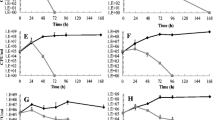Abstract
The antimicrobial activity of lysosomes, a cell organelle, against a range of test microorganisms was examined in this study. The lysosomes isolated from Saccharomyces cerevisiae showed antimicrobial activity to Escherichia coli that positively correlated with the pH of the phosphate buffer as a dissolving solvent. The lysosomes from S. cerevisiae exhibited optimal activity at a concentration of 40%, at pH 4.0 of phosphate buffer, and at broad range temperature, except of over 50°C. It was also found that the lysosomes have antimicrobial activity against seven different microorganisms including E. coli. In addition, S. cerevisiae were exposed by a treatment with H2O2 and lysosomes were isolated from H2O2 exposed S. cerevisiae. We found that fluorescent intensities of each isolated lysosomes were increased depending on the increment of treated H2O2 concentration, and the lysosomes from 20 mM H2O2 treated S. cerevisiae showed higher antimicrobial activity than those from normal S. cerevisiae. Therefore, it suggests that lysosomes isolated from S. cerevisiae can be used as an antimicrobial agent. In addition, lysosomes activated by H2O2 enhanced its antimicrobial activity.



Similar content being viewed by others
References
Bruce A, Johnson A, Lewis A, Raff M, Roberts K, Walter P (2002) Molecular biology of the cell, 4th edn. Garland Science, New York, pp 739–765
Dennes A, Madsen P, Nielsen MS, Petersen CM, Pohlmann R (2002) The yeast Vps10p cytoplasmic tail mediates lysosomal sorting in mammalian cells and interacts with human GGAs. J Biol Chem 227:12288–12293
Gallis HA, Miller SE, Wheat RW (1976) Degradation of 14C-labeled streptococcal cell walls by egg white lysosome and lysosomal enzymes. Infect Immun 13:1459–1466
Glick AD, Ranhand JM, Cole RM (1972) Degradation of group A streptococcal cell walls by egg-white lysozyme and human lysosomal enzymes. Infect Immun 6:403–413
Gu F, Gruenberg J (1999) Biogenesis of transport intermediates in the endocytic pathway. FEBS Lett 452:61–66
Guérin-Dubiard C, Pasco M, Hietanen A, Quiros del Bosque A, Nau F, Croguennec T (2005) Hen egg white fractionation by ion-exchange chromatography. J Chromotogr A 1090:58–67
Han S, Yang Y (2005) Antimicrobial activity of wool fabric treated with curcumin. Dyes Pigments 64:157–161
Hemmings BA, Zubenko GS, Hasilik A, Jones EW (1981) Mutant defective in processing of an enzyme located in the lysosome-like vacuole of Saccharomyces cerevisiae. Proc Natl Acad Sci 78:435–439
Holt OJ, Gallo F, Griffiths GM (2006) Regulating secretory lysosomes. J Biochem 140:7–12
Kim HP, Lee JY, Jeong JK, Bas SW, Lee HK, Jo I (1999) Nongenomic stimulation of nitric oxide release by estrogen is mediated by estrogen receptor α localized in caveolae. Biochem Biophys Res Commun 263:257–262
Li SC, Kane PM (2008) The yeast lysosome-like vacuole: endpoint and crossroads. Biochim Biophys Acta doi:10.1016/j.bbamcr.2008.08.003
Matile P, Wiemken A (1967) The vacuole as the lysosome of the yeast cell. Arch Mikrobiol 56:148–155
Mechler B, Hirsch HH, Müller H, Wolf DH (1988) Biogenesis of the yeast lysosomes (vacuole): biosynthesis and maturation of proteinase yscB. EMBO J 7:1705–1710
Mellman I (1996) Endocytosis and molecular sorting. Annu Rev Cell Dev Biol 12:575–625
Nagaraj N, Vigneswaran N, Zacharias W (2007) Hypoxia inhibits TRAIL-induced tumor cell apoptosis: involvement of lysosomal cathepsins. Apoptosis 12:125–139
Shibko S, Tappel AL (1965) Rat-kidney lysosomes; Isolation and properties. Biochem J 95:731–741
Sine Y-O, Rodil E, Vera JH (2003) Selective precipitation of lysozyme from egg white using AOT. J Food Sci 68:595–599
Tardy C, Codogno P, Autefage H, Levade T, Andrieu-Abadie N (2006) Lysosomes and lysosomal proteins in cancer cell death (new players of an old struggle). Biochim Biophys Acta 1765:101–125
William AD (1994) Autophagy and related mechanisms of lysosome-mediated protein degradation. Trends Cell Biol 4:139–143
Zhao M, Antunes F, Eaton JW, Brunk UT (2003) Lysosomal enzymes promote mitochondrial oxidant production, cytochrome C release and apoptosis. Eur J Biochem 270:3778–3786
Acknowledgments
This research was financially supported by the Ministry of Knowledge Economy and Korea Industrial Technology Foundation (KOTEF) through the Human Resource Training Project for Regional Innovation. The authors are grateful for their support.
Author information
Authors and Affiliations
Corresponding authors
Rights and permissions
About this article
Cite this article
Yoon, J., Park, JM., Jung, SK. et al. Characterization of Antimicrobial Activity of the Lysosomes Isolated from Saccharomyces cerevisiae . Curr Microbiol 59, 48–52 (2009). https://doi.org/10.1007/s00284-009-9392-0
Received:
Revised:
Accepted:
Published:
Issue Date:
DOI: https://doi.org/10.1007/s00284-009-9392-0



